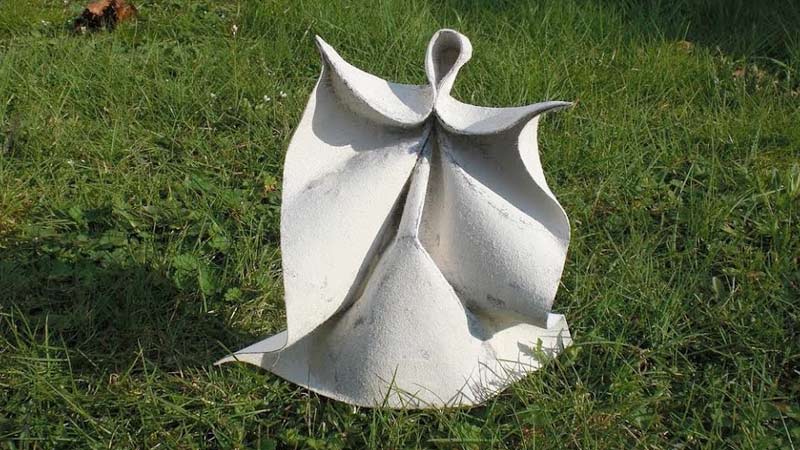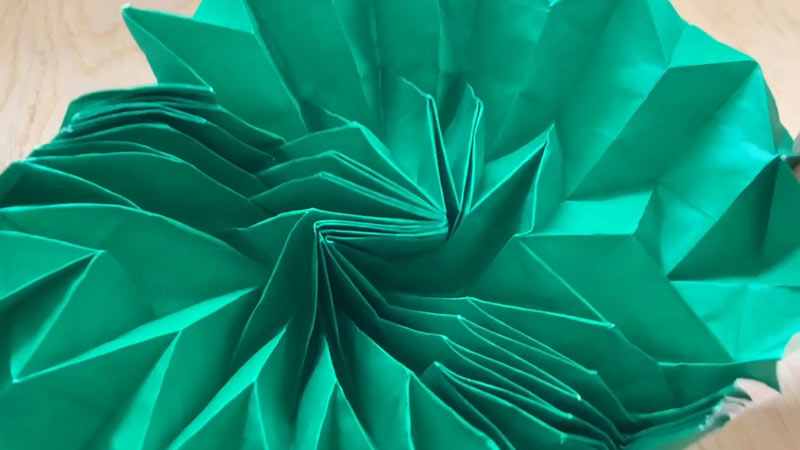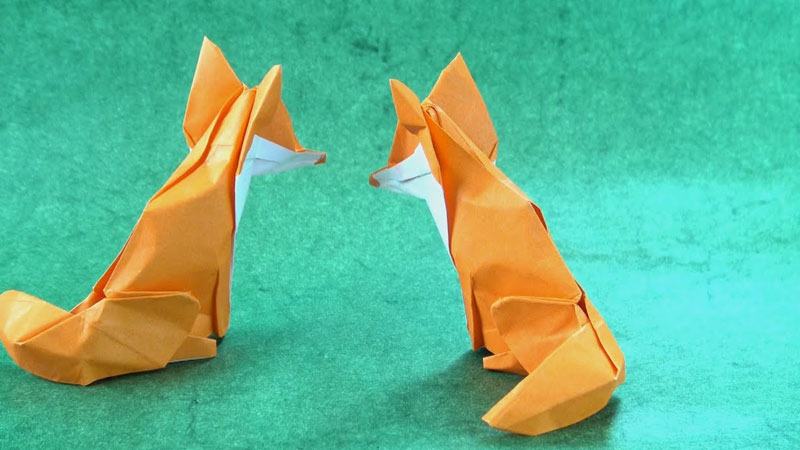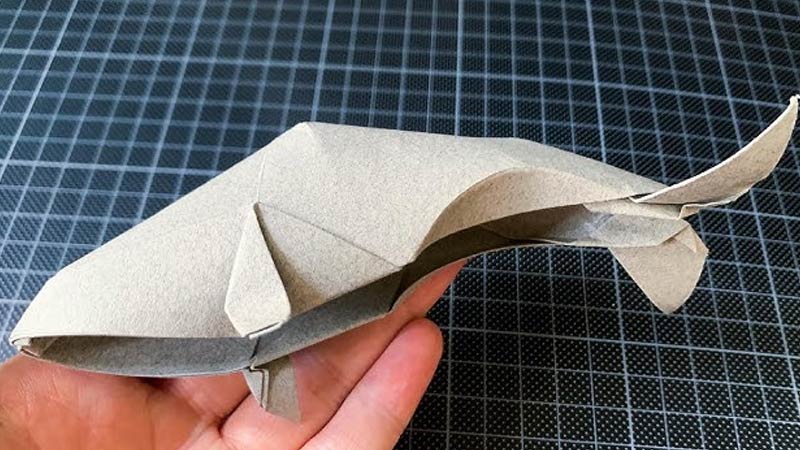Wet folding origami is an advanced and artistic variation of the traditional Japanese paper-folding art form. Unlike conventional origami, where dry paper is meticulously folded into geometric shapes, wet folding introduces an intriguing twist.
It involves the gentle application of moisture to the paper, rendering it pliable and allowing artists to craft stunning, lifelike sculptures with organic curves and naturalistic textures.
This technique places a strong emphasis on aesthetics, enabling origamists to infuse their creations with a sense of depth and realism.
The wet folds meaning is a captivating fusion of artistry and scientific understanding of paper behavior when exposed to moisture, resulting in intricate and captivating folded artworks.

What Is Origami Wet Folding? -The Definition
Origami wet folding is a distinctive and advanced technique in the art of paper folding. Unlike traditional origami, where dry, crisp paper is folded into precise geometric shapes, wet folding involves using a dampened sheet of paper.
This moisture softens the paper fibers, making them more pliable and allowing for graceful, sculptural creations with gentle curves and organic forms.
The key characteristic of wet folding is the artist’s ability to mold the paper, coaxing it into three-dimensional shapes that resemble natural objects or living creatures.
This method emphasizes aesthetics and realism, allowing origamists to infuse their creations with a lifelike appearance and a sense of depth. Wet folding is often employed to craft intricate animal figures, botanical designs, and other complex subjects.
The technique demands both skill and creativity, as artists must strike a balance between the paper’s flexibility and its structural integrity.
Wet folding represents a fascinating fusion of artistic expression and scientific understanding of paper’s behavior when exposed to moisture, resulting in captivating origami sculptures that blur the line between art and nature.
What Is Wet Folding Origami for Beginners?
Wet folding origami for beginners is a creative and accessible variation of traditional origami that incorporates a dampened paper-folding technique.
Unlike standard dry origami, where precise folds and angles are essential, wet folding allows beginners to work with more forgiving, pliable paper, making it an excellent starting point for those new to the art.
Here’s an overview of wet folding origami for beginners:
Dampened Paper
In wet folding, beginners lightly moisten their origami paper, typically with a damp brush or cloth. This moisture softens the paper fibers, making it easier to manipulate and shape.
Simplified Designs
Wet folding projects for beginners often feature simple, rounded, and organic shapes. These can include basic animals, flowers, or abstract forms, allowing newcomers to focus on the technique without the complexity of intricate folds.
Emphasis on Creativity
Wet folding encourages beginners to explore their creative side. They can experiment with shaping the paper to create 3D effects, gentle curves, and realistic textures, adding a personal touch to their creations.
Step-by-Step Instructions
Beginners benefit from clear, beginner-friendly instructions with easy-to-follow diagrams or videos. These resources help novices grasp the wet folding process and create their first pieces.
Hands-On Learning
Wet folding origami provides beginners with a tactile and hands-on learning experience. It improves fine motor skills, patience, and an understanding of how paper behaves when exposed to moisture.
Opportunities for Improvement
While wet folding is forgiving, beginners can gradually challenge themselves with more complex designs as their skills improve. They can also experiment with different levels of moisture to achieve desired effects.
What Is Wet Folding Origami for Kids?

Wet folding origami for kids is a creative and engaging variation of the traditional paper-folding art, adapted to make it accessible and enjoyable for children. It involves using dampened paper to create fun, sculptural origami projects.
Here’s what wet folding origami for kids entails:
Kid-Friendly Designs
Wet folding origami projects for kids typically feature simple, colorful, and visually appealing designs.
These can include animals, flowers, basic geometric shapes, and other objects that capture a child’s imagination.
Dampened Paper
Instead of using dry paper, kids lightly dampen their origami paper with a brush or a damp cloth. This step makes the paper more pliable and forgiving, which is helpful for younger children who may struggle with precise dry folding.
Easy-to-Follow Instructions
Instructions for wet folding origami for kids are usually simplified and accompanied by clear, step-by-step illustrations or videos. This makes it easier for children to understand and follow along.
Creative Expression
Wet folding encourages kids to explore their creativity by allowing them to add their unique touches. They can mold the paper to create 3D effects, add texture, and even paint or decorate their creations once they’re dry.
Hands-On Learning
Wet folding origami provides a hands-on learning experience for kids, teaching them patience, fine motor skills, and the satisfaction of creating something beautiful with their own hands.
Parental Guidance
Depending on their age and skill level, younger children may require some guidance and supervision from parents or caregivers, especially when handling water and shaping damp paper.
What Is Wet Folding Origami Animals?

Wet folding origami animals are intricate and artistic paper sculptures of animals created using the wet-folding technique in origami.
This specialized approach involves using dampened paper to craft animal figures with a lifelike appearance, gentle curves, and organic textures, giving the impression of animals in their natural habitat.
Here’s what wet folding origami animals involve:
Dampened Paper
In wet folding origami animals, high-quality paper is slightly moistened using a brush or other applicator.
This moisture softens the paper fibers, making them more pliable and allowing for the creation of organic shapes.
Emphasis on Realism
Wet folding is particularly suited for animal origami due to its capacity to mimic the natural forms and textures found in the animal kingdom. Artists focus on achieving a realistic and detailed representation of the chosen animal.
Complex Sculpting
Crafting wet-folding origami animals requires intricate folding and sculpting techniques. Artists manipulate the damp paper to create the anatomical features, fur, feathers, scales, or other distinctive characteristics of the chosen animal.
Artistic Expression
Wet folding origami animals provide a platform for artistic expression. Origamists can inject their unique style and creativity into the design, choosing colors, textures, and details to enhance the realism and aesthetics of their creations.
Challenges and Mastery
Creating wet-folding origami animals is considered a challenging endeavor that requires both technical skill and artistic vision.
Artists often spend considerable time perfecting their craft and honing their ability to control moisture levels and shape the paper effectively.
Variety of Subjects
Wet folding origami animals can encompass a wide range of species, from mammals and birds to insects, marine life, and more. Artists select their subjects based on personal interest and artistic inspiration.
How to Wet Fold Origami

Wet folding in origami is an advanced technique that involves shaping paper with moisture to create intricate, three-dimensional designs.
Here’s a detailed guide on how to wet fold origami:
1. Gather Your Materials
Begin by assembling your materials. You’ll need a sheet of sturdy paper suitable for wet folding, a container of clean water, and a soft brush.
Opt for paper that can handle moisture without tearing or losing its shape, such as watercolor paper or specialized origami paper.
2. Prepare Your Paper
Carefully cut or trim your paper to the size and shape required for your origami project. To moisten the paper, use the brush to lightly apply water across the entire surface. Ensure the paper is damp but not saturated, as excessive moisture can make it too fragile.
3. Select a Design
Choose an origami design that complements wet folding. Designs featuring organic, flowing, or lifelike elements are ideal candidates for this technique.
Such designs will allow you to take full advantage of wet folding’s capacity for creating natural, three-dimensional shapes.
4. Start Folding
Begin folding your model as you would with traditional origami. Create the initial creases and folds to establish the foundation of your design. Keep in mind that wet folding will add dimension and realism to your work.
5. Apply Wet Folding Techniques
As you progress through the design, use the dampness of the paper strategically. Gently mold the paper with your fingers to create gentle curves, depth, and organic shapes. The brush can be used to add water to specific areas that require increased pliability. This step allows you to infuse your origami with a lifelike quality.
6. Shape and Sculpt
Wet folding offers the unique ability to sculpt the paper into more rounded, natural forms. Employ your fingers or specialized shaping tools to manipulate the paper and bring out the desired three-dimensional appearance. Take your time to finesse the details and achieve a realistic look.
7. Allow for Drying
After shaping your origami, set it aside to dry completely. The drying time can vary based on the type of paper and the level of moisture applied. Be patient during this stage, as the paper will firm up and retain its shaped form as it dries.
8. Final Adjustments
Once your wet-folded origami piece is dry, make any final refinements or adjustments to enhance its realism and overall aesthetics.
Fine-tune the curves, add details, and ensure your creation accurately reflects your intended design.
What Is the Difference Between Wet Paper Folding and Classic Paper Folding?
Wet paper folding and classic paper folding, also known as dry folding, are two distinct techniques within the art of origami.
Here are the key differences between the two:
Moisture Content
- Wet Folding: In wet folding, the paper used for origami is lightly dampened before folding. The introduction of moisture makes the paper more pliable and allows for sculpting and shaping into three-dimensional forms. The moisture content in wet folding is a critical factor, as it affects the paper’s flexibility and how it holds its shape.
- Classic/Dry Folding: In classic or dry folding, standard origami is performed with dry paper. Dry folding relies on precise folds and creases to create geometric shapes, and the paper remains crisp and rigid.
Style and Aesthetics
- Wet Folding: Wet folding is often characterized by its emphasis on creating organic and naturalistic forms. It is used to sculpt lifelike, rounded, and textured shapes, making it ideal for crafting animals, flowers, and other objects that mimic real-world counterparts.
- Classic/Dry Folding: Classic origami typically focuses on creating precise, geometric designs and abstract shapes. The emphasis is on mathematical precision and symmetry.
Forgiveness and Complexity
- Wet Folding: Wet folding is generally more forgiving than dry folding, especially for beginners. The dampened paper allows for corrections and adjustments, making it suitable for more complex and intricate designs that require shaping and sculpting.
- Classic/Dry Folding: Dry folding is often associated with more intricate and complex designs that demand precise folding techniques. Mistakes can be less forgiving and may require starting over, making it somewhat less beginner-friendly.
Sculpting and Realism
- Wet Folding: Wet folding is renowned for its ability to create sculptures with depth, curves, and lifelike details. Artists use the technique to add realism and dimension to their origami creations.
- Classic/Dry Folding: Classic origami typically focuses on achieving precise geometric shapes and symmetry without emphasizing realism or three-dimensionality.
FAQS
Is wet folding origami suitable for beginners?
Wet folding can be challenging for beginners due to the need for precise moisture control and shaping skills.
Can any paper be used for wet folding?
While many types of paper can be used for wet folding, it’s essential to choose paper that can withstand moisture without disintegrating.
Does wet folding origami require any special tools or equipment?
Wet folding primarily requires paper, water, and a soft brush for dampening. However, some artists may use shaping tools or aids to achieve specific effects in their creations.
Can wet-folded origami creations be preserved long-term?
Wet-folded origami pieces may not have the same longevity as dry-folded ones, but they can be preserved for an extended period with proper care.
Are there any famous artists known for their wet folding origami creations?
Yes, several origami artists are renowned for their wet folding expertise.
To Recap
Wet folding origami is a captivating and advanced technique that elevates the art of paper folding to new heights.
It embraces the dynamic interplay between paper and moisture, allowing artists to create expressive, three-dimensional sculptures that blur the line between origami and sculpture.
The emphasis on aesthetics, realism, and creativity in wet folding opens up a realm of artistic possibilities, from crafting lifelike animals to intricate botanical designs.
It challenges practitioners to master the delicate balance between dampness and structural integrity.
Ultimately, wet folding represents a fusion of artistic vision and scientific understanding, resulting in exquisite origami creations that showcase the beauty and complexity achievable through this unique and captivating method.
Leave a Reply